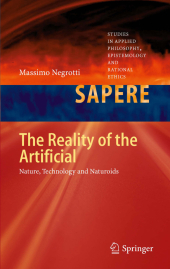 Neuerscheinungen 2014Stand: 2020-02-01 |
Schnellsuche
ISBN/Stichwort/Autor
|
Herderstraße 10
10625 Berlin
Tel.: 030 315 714 16
Fax 030 315 714 14
info@buchspektrum.de |

Massimo Negrotti
The Reality of the Artificial
Nature, Technology and Naturoids
2012. 2014. viii, 160 S. 235 mm
Verlag/Jahr: SPRINGER, BERLIN; SPRINGER 2014
ISBN: 3-642-44353-2 (3642443532)
Neue ISBN: 978-3-642-44353-4 (9783642443534)
Preis und Lieferzeit: Bitte klicken
Building on the concept of the naturoid, this book examines activities aimed at the reproduction of something existing in nature, whose reproduction, through construction strategies different from natural ones, we consider useful, appealing or interesting.
The human ambition to reproduce and improve natural objects and processes has a long history, and ranges from dreams to actual design, from Icarus´s wings to modern robotics and bioengineering. This imperative seems to be linked not only to practical utility but also to our deepest psychology. Nevertheless, reproducing something natural is not an easy enterprise, and the actual replication of a natural object or process by means of some technology is impossible. In this book the author uses the term naturoid to designate any real artifact arising from our attempts to reproduce natural instances. He concentrates on activities that involve the reproduction of something existing in nature, and whose reproduction, through construction strategies which differ from natural ones, we consider to be useful, appealing or interesting.
The development of naturoids may be viewed as a distinct class of technological activity, and the concept should be useful for methodological research into establishing the common rules, potentialities and constraints that characterize the human effort to reproduce natural objects. The author shows that a naturoid is always the result of a reduction of the complexity of natural objects, due to an unavoidable multiple selection strategy. Nevertheless, the reproduction process implies that naturoids take on their own new complexity, resulting in a transfiguration of the natural exemplars and their performances, and leading to a true innovation explosion. While the core performances of contemporary naturoids improve, paradoxically the more a naturoid develops the further it moves away from its natural counterpart. Therefore, naturoids will more and more affect our relationships with advanced technologies and with nature, but in ways quite beyond our predictive capabilities.
The book will be of interest to design scholars and researchers of technology, cultural studies, anthropology and the sociology of science and technology.
Part I.- Chap. 1 Daedalus and Icarus.- Chap. 2 Artificiality and Naturoids.- Chap. 3 Duplicating Reality.- Part II.- Chap. 4 The First Step: Observation.- Chap. 5 Observation and Representations.- Chap. 6 The Exemplar and Its Definition.- Chap. 7 Essentiality of Things.- Part III.- Chap. 8 The Mind Reduces Complexity, Reality Does Not Make Discounts.- Chap. 9 The Problem of Synthesis.- Chap. 10 Transfiguration.- Part IV.- Chap. 11 Classification of the Artificial.- Chap. 12 Automatisms and Naturoids.- Chap. 13 Naturoids in Real Contexts: Bionic Man and Robots.- Chap. 14 The Challenge of Complexity.- Chap. 15 Illusion and Compatibility.- Part V.- Chap. 16 Naturoids: Interface and Camouflage.- Chap. 17 Structure or Process?.- Chap. 18 Artificial Limbs: History and Current Trends.- Chap. 19 The Artificial Brain.- Chap. 20 Prostheses, Replacements and Surrogates.- Chap. 21 Artificial Environments and Landscapes.- Chap. 22 Virtual Reality.- Chap. 23 Conclusions.- Appendix A Naturoids and Music.- Sect. A.1 Reproduction and Transfiguration.- Sect. A.2 The Rarefaction of Meaning.- Sect. A.3 Statements by Writers or Scholars in the Humanities.- Sect. A.4 Statements by Composers.- Appendix B Naturoids and Conventional Technology Devices.- References.


